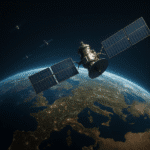Europa, one of Jupiter’s most intriguing moons, has long captivated the imagination of scientists and space enthusiasts alike. With its icy surface and the potential for a subsurface ocean, Europa presents a tantalizing target for exploration. Upcoming missions aim to unlock the secrets of this distant world, offering insights into its geology, potential habitability, and the broader mysteries of our solar system.
The Allure of Europa
Europa’s allure lies in its unique characteristics and the possibility that it may harbor conditions suitable for life. Discovered by Galileo Galilei in 1610, Europa is the smallest of the four Galilean moons orbiting Jupiter. Despite its size, it has become a focal point for astrobiological research due to its icy crust and the strong evidence suggesting a vast ocean beneath its surface.
The surface of Europa is primarily composed of water ice, with a smooth and bright appearance that reflects sunlight, making it one of the most reflective bodies in the solar system. This icy shell is crisscrossed with a network of dark streaks and ridges, believed to be the result of tectonic activity and the movement of ice plates. These features suggest that Europa’s surface is geologically young and dynamic, with the potential for ongoing processes that could support life.
Beneath the ice, scientists hypothesize the existence of a subsurface ocean, kept liquid by the heat generated from tidal forces exerted by Jupiter’s immense gravity. This ocean could be in contact with Europa’s rocky mantle, creating a potential environment for chemical reactions that might support life. The presence of water, energy, and the right chemical ingredients makes Europa one of the most promising places to search for extraterrestrial life within our solar system.
Upcoming Missions to Europa
In response to the scientific potential of Europa, several missions are being planned to explore this enigmatic moon. These missions aim to gather data that will help answer fundamental questions about Europa’s geology, ocean, and potential habitability.
Europa Clipper
One of the most anticipated missions is NASA’s Europa Clipper, set to launch in the 2020s. The Europa Clipper will conduct detailed reconnaissance of Europa’s ice shell and subsurface ocean, using a suite of scientific instruments to study the moon’s surface and interior. The mission will perform multiple flybys of Europa, each time collecting high-resolution images and data on the moon’s composition, geology, and potential for supporting life.
The Europa Clipper’s instruments include ice-penetrating radar to probe the thickness of the ice shell and search for subsurface lakes, a magnetometer to measure the moon’s magnetic field and infer the depth and salinity of the ocean, and a mass spectrometer to analyze the composition of Europa’s thin atmosphere and any plumes of water vapor that may erupt from the surface. These measurements will provide critical insights into the moon’s structure and the potential for habitability.
JUICE Mission
The European Space Agency (ESA) is also planning a mission to explore Jupiter’s icy moons, including Europa. The Jupiter Icy Moons Explorer (JUICE) mission is scheduled to launch in the early 2020s and will focus on Ganymede, Callisto, and Europa. While JUICE’s primary target is Ganymede, it will conduct two flybys of Europa, providing complementary data to the Europa Clipper mission.
JUICE will carry a range of scientific instruments to study the moons’ surfaces, atmospheres, and magnetic environments. For Europa, the mission will focus on characterizing the moon’s surface features and composition, as well as investigating the potential for active processes such as plumes or geysers. The data collected by JUICE will help refine our understanding of Europa’s geology and its potential for supporting life.
The Search for Life
The ultimate goal of these missions is to determine whether Europa could support life. While direct detection of life is unlikely, the missions will search for biosignatures—indicators of biological activity—that could suggest the presence of life. These biosignatures might include specific chemical compounds, isotopic ratios, or patterns in the distribution of organic molecules that are consistent with biological processes.
In addition to searching for biosignatures, the missions will investigate the habitability of Europa’s ocean by studying its chemistry, temperature, and energy sources. Understanding the ocean’s composition and the potential for hydrothermal activity on the ocean floor will provide insights into the types of life that might exist and the conditions necessary for their survival.
Challenges and Future Prospects
Exploring Europa presents significant challenges, from the harsh radiation environment around Jupiter to the technical difficulties of landing on and penetrating the moon’s icy surface. However, advances in technology and international collaboration are helping to overcome these obstacles, paving the way for future missions that could include landers or even submersibles to explore Europa’s ocean directly.
As we look to the future, the exploration of Europa holds the promise of answering some of the most profound questions about life beyond Earth. The data collected by upcoming missions will not only enhance our understanding of this icy moon but also inform the search for life on other ocean worlds in our solar system and beyond. With each new discovery, we move closer to unraveling the mysteries of Europa and the potential for life in the cosmos.










